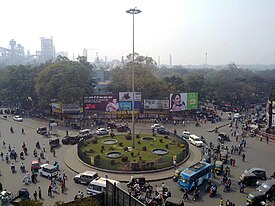
Summary
Sakchi was a village in north eastern Indian territory of Singhbhum which was selected by Jamsetji Tata to be the location of a planned steel city, which in 1919 became Jamshedpur.[1] Sakchi is now part of the city between the Tata Steel site and the river Subarnarekha. Then it was known as Kalimati.[2] Due to the presence of iron ore, river water and sand, Jamsetji Tata decided to establish TISCO (Tata Iron and Steel Company Limited) there. The company is now known as Tata Steel Ltd.[3]
Sakchi | |
|---|---|
Neighbourhood of Jamshedpur | |
| Sakchi | |
 | |
| Coordinates: 22°48′19″N 86°12′08″E / 22.805182°N 86.202282°E | |
| Country | India |
| City | Jamshedpur |
| State | Jharkhand |
| Time zone | GMT + 0530 |
Overview edit
2miles
Khasmahal
River
River
Hospital
Sports Complex
Zoological Park
Junction
railway station
of Technology
Metallurgical
Laboratory
Industrial Area
Motors
works
M: municipal town, F: facility, N: neighbourhood, W: works, factory, C: educational/ research centre
Owing to space constraints in the small map, the actual locations in a larger map may vary slightly
Places marked on this map, which have a separate page, are linked in the larger full scale map.
For map of Jamshedpur Urban Agglomeration see Mango or Adityapur page.
Even today running through Sakchi is the Kalimati Road. During British India, a railway line connecting Jamshedpur to Howrah (Calcutta) was started. Jamshedpur is in the Indian mineral-rich state of Jharkhand which was earlier in South Bihar.
As Tata Steel was established, the first planned urban settlement started in Sakchi area and it included businessmen (Gujaratis, Parsis, Punjabis), servicemen (Biharis, Bengalis, Oriyas, Telugus, Tamils, Malayalis). Many people who then migrated from West Bengal, East Bengal (now Bangladesh), Gujarat and Assam are now permanent residents of Jamshedpur city and their ancestral homes were either lost or sold after separation of East Pakistan (Bangladesh). Old houses of Bengalis, Parsis, Anglo-Indians and Gujaratis can still be seen in Aambagan, Hill Cart Road, Kalimati Road, Pennar road, Sakchi Bazar areas of Sakchi. A few such houses are also present in Bistupur.
Once, there used to be a single line railway track which would carry sand for the factory in present-day Aambagan Maidan near the Masjid, it does not exist anymore. Mode of transport in the Jamshedpur city were buggies and taxis. There were single lane roads with old British style street lamps. Most roads between Sakchi and Bistupur were surrounded by jungles.
The city is unique because it is a very small town even today with extreme ends being covered within 45 minutes (including traffic). It is not a metro city, yet it has the demography of a metro town as people from all ethnicities live here as permanent residents. Sakchi is located in the centre of the city, with Bistupur, Kadma, and Sonari lying in the West. In the East, lies Baradwari, Kasidih, Bhalubasa, Sitaramdera, Agrico and Sidhgora. In the North, lies Mango which is also one of the busiest locations of the city and down south lies Burmamines, Tatanagar station, Jugsalai and Parsudih.
Sakchi today has numerous cinema halls, Sakchi Bazaar which holds Mangla Market (Tuesday market) every Tuesday on footpath. Sakchi Market (or Sakchi Bazaar) is the oldest market in the city.
History edit
In April 1904, Dorabji Tata, Shapurji Saklatvala and C. M. Weld, went on a journey to locate a site rich in iron, coal, limestone and water. One day they reached to Sakchi village, situated in the dense forests of the Chota Nagpur plateau, near the convergence of the Subarnarekha and Kharkai rivers. It appeared to be an ideal choice for a steel plant and the location was selected.[4] Sakchi was a tribal village, mainly inhabited by the Bhumij and Santhal tribes. Sakchi village was populated by 17 families of Bhumij, and its two hamlets – Kashidih consisted 18 families of Bhumij and 3 families of Santhal; and Mahulbeda consisted 17 families of Santhal.[5][6]
The construction of the plant began in 1908, the plant rolled its first steel ingot on 16 February 1912. In 1919, Lord Chelmsford renamed Sakchi to Jamshedpur in honour of its founder, Jamshedji Nusserwanji Tata.
Civic administration edit
There is a police station at Sakchi.[7]
References edit
- ^ "History of Jamshedpur, Facts About Jamshedpur, Jamshedpur History". www.jamshedpuronline.in. Retrieved 16 April 2023.
- ^ "It's been a long journey". www.telegraphindia.com. Retrieved 16 April 2023.
- ^ News, India TV. "Sakchi Pin Code | Postal Code (Zip Code) of Sakchi, East Singhbhum, Jharkhand, India". www.indiatvnews.com. Retrieved 16 April 2023.
{{cite web}}:|last=has generic name (help) - ^ Mukherjee, Rudrangshu (19 July 2008). A Century of Trust: The Story of TATA STEEL. Penguin UK. ISBN 978-93-5118-766-0.
- ^ Journal of Social Research. 1968.
- ^ Association, Indian Science Congress (1968). Proceedings of the Indian Science Congress. Asiatic Society of Bengal.
- ^ "District Police Profile – East Singhbhum". Jharkhand Police. Archived from the original on 22 June 2022. Retrieved 30 December 2021.


